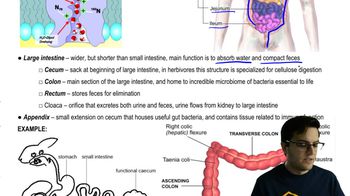Enzymes that break down DNA catalyze the hydrolysis of the covalent bonds that join nucleotides together. What would happen to DNA molecules treated with these enzymes? a. The two strands of the double helix would separate. b. The phosphodiester linkages of the polynucleotide backbone would be broken. c. The pyrimidines would be separated from the deoxyribose sugars. d. All bases would be separated from the deoxyribose sugars.
 Campbell 12th Edition
Campbell 12th Edition Ch. 5 - The Structure and Function of Large Biological Molecules
Ch. 5 - The Structure and Function of Large Biological Molecules Problem 8
Problem 8Construct a table that organizes the following terms, and label the columns and rows.
 Verified step by step guidance
Verified step by step guidance
Verified Solution
Key Concepts
Data Organization

Table Structure

Labeling Conventions

The molecular formula for glucose is C6H12O6. What would be the molecular formula for a polymer made by linking ten glucose molecules together by dehydration reactions? a. C60H120O60 b. C60H102O51 c. C60H100O50 d. C60H111O51
Which of the following pairs of base sequences could form a short stretch of a normal double helix of DNA? a. 5′-AGCT-3′ with 5′-TCGA-3′ b. 5′-GCGC-3′ with 5′-TATA-3′ c. 5′-ATGC-3′ with 5′-GCAT-3′ d. All of these pairs are correct.
DRAW IT Copy the polynucleotide strand in Figure 5.23a and label the bases G, T, C, and T, starting from the 5′ end. Assuming this is a DNA polynucleotide, now draw the complementary strand, using the same symbols for phosphates (circles), sugars (pentagons), and bases. Label the bases. Draw arrows showing the 5'→3' direction of each strand. Use the arrows to make sure the second strand is antiparallel to the first. Hint: After you draw the first strand vertically, turn the paper upside down; it is easier to draw the second strand from the 5′ toward the 3′ direction as you go from top to bottom.